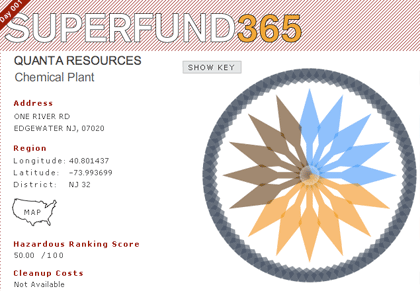Archive for the ‘society_technology’ Category
Play the NSA Game

Don’t make the wrong choice! Pick the word that isn’t on the NSA surveillance list.
Play the NSA Game by choosing which word is a “Terrorist Threat or Harmless Phrase?” an NSA word guessing game. You will see two words, one is listed in the NSA’s watch list, the other is not, can you guess which one is not listed? The two words are set against a blue sky background with puffy clouds, flying birds, green grass and a nice tree. However, every time that you guess wrong a hidden image below the natural landscape is revealed, a dark image of a surveillance society.
Four wrong guesses and the natural landscape is entirely gone, instead a Google search window appears with your bad picks filled into the search field… Click search and your IP may now be added to the NSA watch list as you search for key terms on the NSA database.

Once you loose the game, which you eventually will, your bad choices will be typed into a Google search field, click search and risk having your IP added to the NSA red list!
The project is a second of a series by artist Grayson Earle who a few weeks ago created NSA Haiku Generator that does just what the title describes. With both of these projects the artist is problematizing the fact that the NSA maintains such a list and the list itself. The games portray how inane the list is and contribute to their pointlessness by generating more searches with these terms by anyone playing the games.
See a physical installation by the artist titled “NSA Lights” at the Roosevelt House Public Policy Institute this Saturday, December 14th, 2013 located at 47-49 East 65th Street, New York as part of Hunter’s Integrated Media Arts MFA exhibition.
Ivan Puig at MagnanMetz
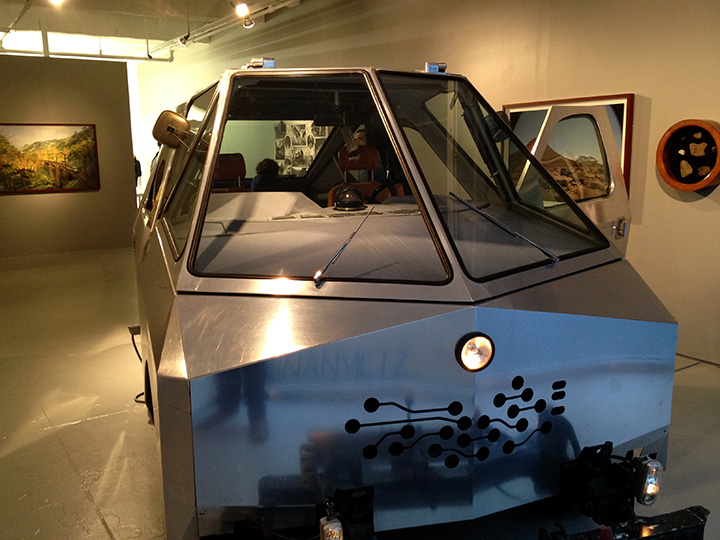
Ivan Puig’s SEFT-1 probe at MagnanMetz Gallery, Chelsea, NYC through March 9, 2013
Following the opening of Mexican artist Ivan Puig’s solo show at MagnanMetz gallery in New York City, Iggy and I visited with Puig and caught up regarding the SEFT-1 project (SEFT is an acronym for Sonda de Exploración Ferroviaria Tripulada or Manned Railway Exploration Probe). I first learned about the project in 2006 when Puig was just getting started on the concept of exploring abandoned railroads through out Mexico using a vehicle designed to travel the on the railroad tracks as well as car roads when necessary. Ivan was interested in seeing first hand what had happened to the communities that were built along the tracks and largely subsisted from the trains running throughout Mexico. Many of these communities are small rural populations that depended on the trains for various needs.
Puig spend a year traversing the abandoned railroad system with his half-brother Andrés Padilla Domene. As described on the exhibitions press release “The two set off from the National Museum of Art in Mexico City to begin their investigation of abandoned railways throughout Mexico and Ecuador, collecting evidence of their travels through photo, video and audio. Puig and Padilla Domene recorded contemporary landscapes, infrastructure and details of the everyday life of inhabitants to create a futuristic exploration of the countries’ pasts. Their progress has been consistently updated on the project’s website, www.seft1.com, where the public can follow the trajectory of the vehicle, view images of artifacts collected and listen to interviews with those they have met along the way.”
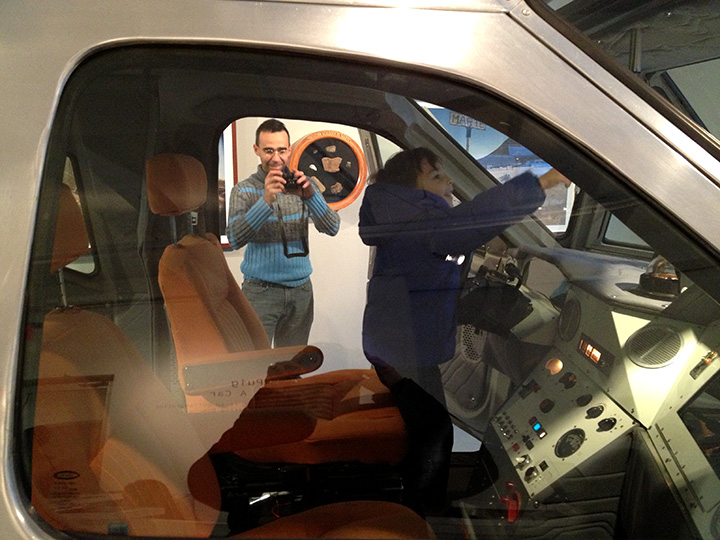
Ivan taking a picture of Iggy inside SEFT-1, a special treat as he was allowed into the sculpture
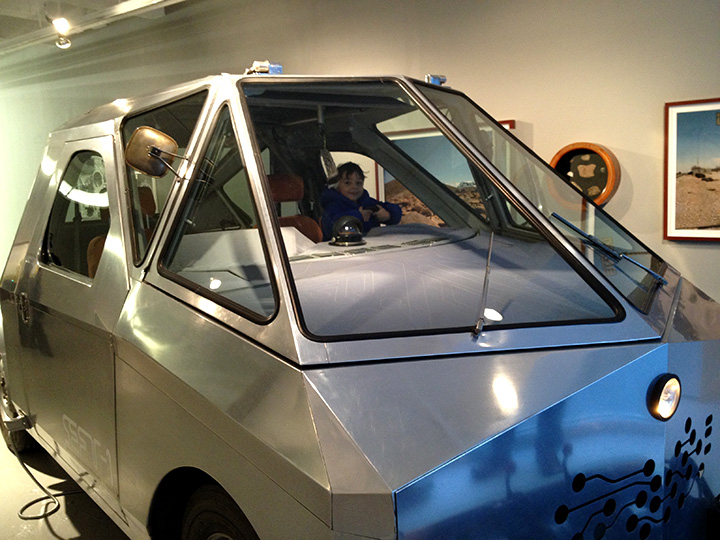
Iggy inside SEFT-1
It appears that the SEFT-1 will be traveling to the UK to explore abandoned railways throughout the British countryside sometime in the next year. By doing so, the artist will expand the archive of stories regarding locomotive technology and the communities surrounding the technology.
Public Broadcast Cart in fall 2011 Art Journal
Sarah Kanouse has published an excellent essay on radio as art practice in the public space. The essay “Take It to the Air: Radio as Public Art” is printed in the fall 2011 Art Journal and discusses three different art projects utilizing radio as the primary medium. Following the introduction, Sarah discusses the work of Jon Brumit and Neighborhood Public Radio, my own Public Broadcast Cart and the work of art collective LIGNA. The final wrap up of the essay is quite inspiring:
In these projects, radio is a prosthetic technology that transmits the physical world into the space of electronic communications and materializes the vast space of electromagnetic resources into something material and physically apprehensible. In so doing, it forces a confrontation with and contestation of the rules that govern and control the use of both spaces, positioning radio for creative interventions in manifold public spaces – not only those we inhabit with our bodies, as much of the best public art does, but also those we inhabit with our passions, our excesses, our energies, and our speech.
Señal 3 – Community Television in La Victoria, Santiago, Chile
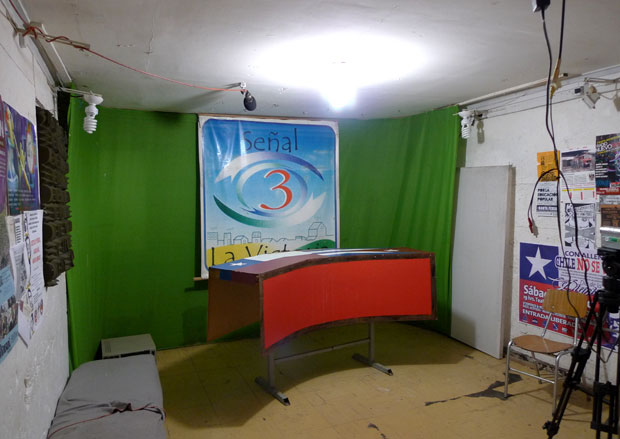
During our stay in Santiago at the end of July to beginning of August, the curator of “portables” and our host, Ignacio Nieto took us to a community television station and media school, Señal 3 (Signal 3). Located in La Victoria, considered amongst the poorest and most dangerous neighborhoods of Santiago, Señal 3 pirates its signal to the immediate area. The government and police do not intervene, because they are afraid to enter the neighborhood.
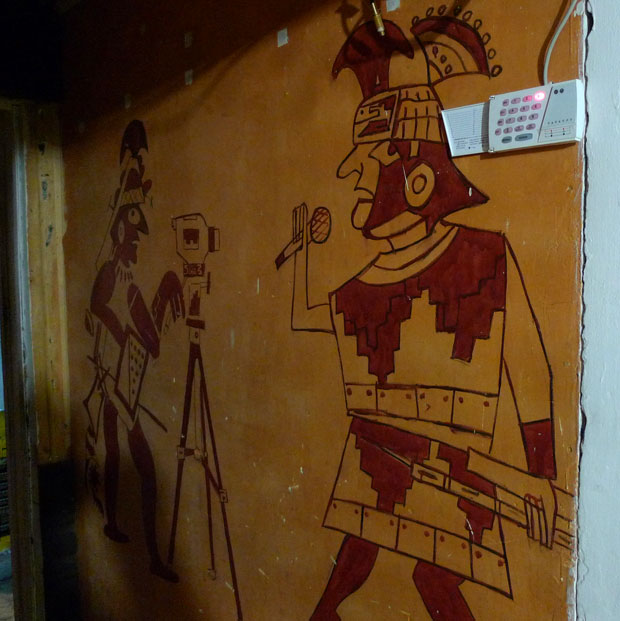
A mural in the hallway leading from the television recording studio to the post-production and broadcast studio.
During the visit, I took the opportunity to interview one of the members who established and helps maintain the community TV station. Learning in detail about the history of Señal 3, seeing their outfit and what they have created as well as their mission is absolutely inspiring. The men who established and run Señal 3 grew up together in La Victoria and were once vigilantes of their neighborhood… ignored by the police and government, it was up to the community to keep the peace. The members of Señal 3 earn a living through video production as they maintain a pirate television station that they’ve transformed into a local media center.
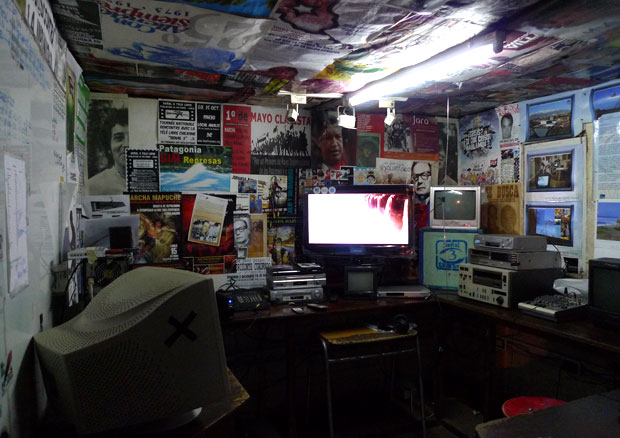
The broadcast studio.
Community media has a long history in La Victoria. In the 70s the neighborhood ran pirate radio, in the 80s the local church was given large televisions that would be stationed on various corners of the neighborhood for major soccer games. Señal 3 with it’s current members has been broadcasting since 1997.
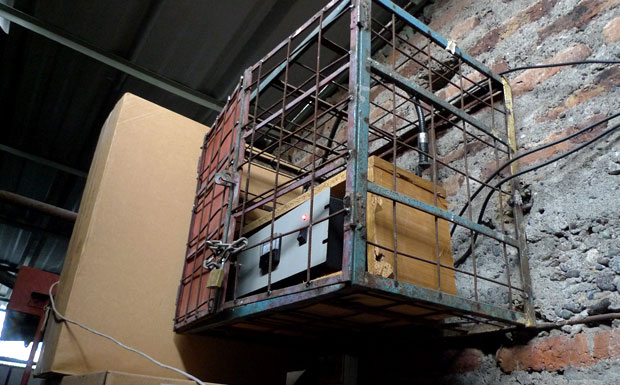
The transmitter in a converted alley way between houses.
The television broadcast was once bounced from member home to member home as necessary. However, several years ago, the home next to one of the members was raided by the police. The owner was selling drugs and pimping girls. He spent time in jail and upon returning to his home the neighborhood would not allow him to remain. The members of Señal 3 made a bid for the drug dealer’s home and then transformed it from a drug den and under age brothel to a community media center… they established a home for their transmitter.
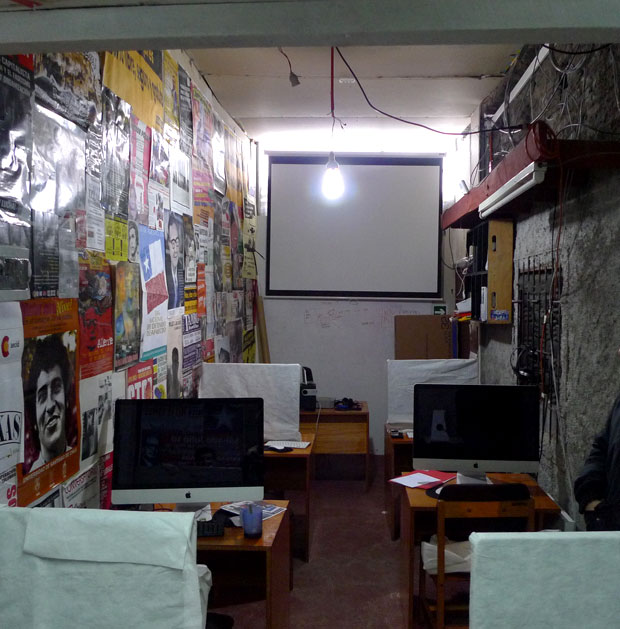
The classroom!
Today the house has a dedicated television studio, a mixing and production studio and media classroom. The members were always dedicated to community television production and working with local kids and neighbors to create programming. However a three years ago, Señal 3 was awarded a major grant by a Spanish institution. They used that grant to establish a proper classroom, equipped with high end iMacs and a projector. Each school year, Señal 3 accepts a handful of kids to run a year long media production course that covers video production – shooting, editing and broadcast as well as computer graphics and web programming. Their intention is simply to make these kids into media producers rather than passive consumers.
Soon they will begin fund raising for the next enterprise, a new building where Señal 3’s current home stands. The new building will offer the community better production facilities, larger classroom… a place where kids in the neighborhood will have access to tools that Chile’s educational system will never make available to those of La Victoria.
Home Taping Is Killing Music
I recently received a Cablevision courtesy letter letting me know that illegal download activity had been tracked via my account! Must have been a neighbor. Wont those pirating evil-doers ever learn, content isn’t free! Here’s a great video from Dan Bull, reminiscing on the days when copyright infringement revolved around mix tapes. Little did they envision what the digital age would mean to distribution.
The Shock Doctrine film short
“Only a crisis, real or perceived, produces real change” stated Milton Friedman, economist and vanguard of the free market and indeed the free market has prospered through human suffering. Friedman is a classic Conservative who believed that if one suffered, tough, one was dealt a poor lot, it is not upto society to fix the situation. According to Naomi Klein and Alfonso Cuaron there is hope for the disenfranchised even during the rule of the free market.
Hope is knowledge and communication (the basis of Enlightenment ideals – classical Liberalism) – “to resist shock is to know what is happening to you and why”. I’ve tried to believe this for a long time, but when I read of what is happening in our world and to consider the parallels of how it has happened before even within my liftime (and I’m not old), it’s difficult to believe in information as shock resistance. And hell, I’m a firm believer in informationalism, but one must have some level of entitlement, whether by birth, geographic location, migration, or availability of information. To say that information is resistance, assumes a great deal and only one that is entitled would be so careless to make that declaration. Perhaps the liberal revolution has lost to a powerful deity, one that was always with us, human nature – lust, gluttony, greed, sloth, wrath, envy, pride… the engines of Western civilization.
Zimbra is amazing!
My school recently switched to a new email client, Zimbra, which I avoided for a while, because I felt like it had too much going on and it takes a while to load and I was just used to the good’ol squirrel client. But Zimbra is amazing, it’s like the web in hyper drive. Zimbra is an early “web2.0” product that needs code updating for some platforms, but it’s only crashed my browser once and works well otherwise. For example, I received an Amazon notice that my order had shipped with the UPS tracking number. After spending nearly an hour at the post office yesterday and watching people in line nearly get into fights, I’ve decided that I’m going to closely track the package as not to miss it. The tracking number was a hyperlink, so I clicked on it and a new window opened up with the UPS page for my item. Generally, I’d copy the number, go to the UPS site and paste it… Also any address are also hyperlinked so that an ajax preview box pops up with a yahoo map of the location (yahoo recently acquired Zimbra). I’m sure Zimbra is old news to people, but it’s a surprise to me. Best of all it’s open source and free to download.
Superfund365 Launched!
High numbers of children with asthma? Adults afflicted with cancer? What was previously buried in the land near a small town? What pollutants flow in the tap water of a given region? Are you living near a Superfund Site? In 1980, Reagan reluctantly implemented the Superfund Act, initially written by the Carter administration due to civic demand for the government’s acknowledgment and action to clean up hazardous sites.
Today the Superfund is broke, there is little money to clean up past sites of waste and environmental disasters, but people still have a right to know and to learn about the environments we live in, however the Environmental Protection Agency doesn’t make this easy. Concerned citizens may request Superfund data from the EPA, but the data tends to be dirty – missing information or out dated information, so it’s a good thing that Brooke Singer (full disclaimer – she’s my wife) with the support of turbulence.org has launched Superfund365.
Each day from September 1st 2007 through August 2008, Singer will post a data visualization of a Superfund site. Superfund365 presents a wealth of information on the United States environmental reality. As there are thousands of Superfund sites in the United States of America, Superfund365 only paints a partial picture of the damage to this region of the world, however it is enough to get an insight into the environmental disasters heaped by industrialization and commerce. The project is an incredible exercise of environmental data visualization at a time when people are becoming increasingly conscious of the changes that we have inflicted upon our planet.
Where You Are
September 15, 2005
A new experiment by Sal Randolph – “Whereyouare is an experiment in the collective documentation of neighborhoods… Everyone is invited to participate by documenting any neighborhood they love… The project harnesses the power of folksonomy tags from a range of sites that host and organize content of different kinds (flickr for photos, vimeo for video, delicious for links, etc.).”
I love the concept of this experiment and it’s use of current popular web tools too establish an open documentation of neighborhoods that anyone who is willing to establish an account with flickr or vimeo or delicious or opsound… can participate in.
At the moment, Williamsburg seems to have the most stuff, since it is the neighborhood that Sal lives in and can facilitate getting initial contributors to join.
If people contribute worthwhile content and build an engaging representation or documentation, it could be a really great use of folksonomy. However at the moment, Williamsburg includes a couple of videos of an awning flapping against wind and some pigeons hanging out on a street – the sort of content that leads me to question whether or not this is just more unnecessary stuff online, time will tell.
It will also be interesting to see how widely the site is passed along and if neighborhoods of non-Western or underdeveloped countries are added to the site.
Icann, Bush and Regression
July 04, 2005
The Bush administration’s regressive nature toward late capitalism is once again made apparent in today’s announcement that the government will keep control of the computers that manage the Internet. As usual the Bush administration is using security and guarding against global terrorism as the reasoning behind not moving forward in the global development of the WWW. The Internet would be well served if the root servers did not remian under the control of one government, this was necessary 30 years ago, and even 15 years ago as USSR came to an end, today it portrays the unilateral nature of the current administration. It will be interesting to see if Internet Corporation for Assigned Names and Numbers, or Icann remains part of the Commerce Department or becomes a private corporation as scheduled for Sept. 2006…
